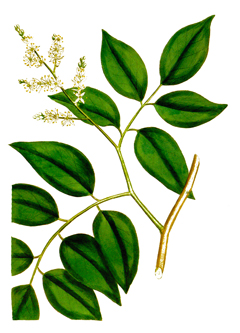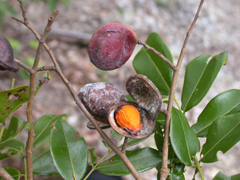 |
|
https://edibleplants.org/ |
 |
| A. Fuentes |
Translate this page:
Summary
Copaifera reticulata is a large, evergreen tree that grows up to 30 - 45 meters tall. It has a straight, cylindrical bole that can be branchless for 30 m. It is found in the humid forests in South America particularly in Bolivia, Brazil, and Peru. Like other species in the Copaifera genus, it is a source of an oily oleo-resin known as copaiba-balsam. The resin is used as a food additive and as flavouring agents in food and beverages. It is also used in perfumery, cosmetics, varnishes and lacquers, and as substitute to diesel oil. Medicinally, it is used to treat various conditions in the skin, urinary tract, respiratory system, and reproductive systems. It can also be used for pain relief, headache, sore throat and mouth sores. The bark also yields tannin. The wood is used in general carpentry and construction, and as material in making furniture.
Found In: South America: Bolivia, Brazil and Peru. Other Names: Reticulated Copaiba, Copaiba Balsam
Physical Characteristics

 Copaifera reticulata is an evergreen Tree growing to 30 m (98ft) by 30 m (98ft) at a slow rate.
Copaifera reticulata is an evergreen Tree growing to 30 m (98ft) by 30 m (98ft) at a slow rate.
See above for USDA hardiness. It is hardy to UK zone 10.
It can fix Nitrogen.
Suitable for: light (sandy) and medium (loamy) soils and prefers well-drained soil. Suitable pH: mildly acid, neutral and basic (mildly alkaline) soils. It can grow in full shade (deep woodland) or semi-shade (light woodland). It prefers dry or moist soil.
UK Hardiness Map
US Hardiness Map
Synonyms
Copaifera reticulata var. reticulata
Plant Habitats
Edible Uses
Edible Parts:
Edible Uses: Condiment
The resin has been approved officially in the U.S. as a food additive and is used in small amounts as a flavouring agent in foods and beverages[ 318 ].
References More on Edible Uses
Medicinal Uses
Plants For A Future can not take any responsibility for any adverse effects from the use of plants. Always seek advice from a professional before using a plant medicinally.
Anodyne Antacid Antibacterial Antifungal Antiinflammatory Antiseptic Antitumor Aromatic
Astringent Cytostatic Demulcent Digestive Disinfectant Diuretic Eczema
Expectorant Kidney Laxative Skin Stimulant Urinary Vermifuge
Copaiba-balsam, an oily oleo-resin obtained from the trunk of the tree, has a very long history of use medicinally. It was widely used by the native peoples prior to the Europeans reaching S. America and these uses were soon taken up by the Europeans[ 317 ]. The resin is especially valued for its ability to counter mucous in the chest and genito-urinary system[ 254 ]. The resin is an aromatic, stimulant herb with a bitter, burning taste[ 238 ]. Both it and the bark are anodyne, antacid, antibacterial, antifungal, antiinflammatory, antimicrobial, astringent, cytostatic, demulcent, digestive, disinfectant, diuretic, expectorant, mildly laxative, vermifuge and vulnerary[ 318 ]. The resin obtained from the trunk contains a number of medically active constituents including 30 - 90% essential oils and unusual condensed tannins[ 238 ]. The essential oil contains alpha- and beta-caryophyllene, sesquiterpenes, resins and terpenic acids[ 254 ]. It improves the digestion, has diuretic and expectorant effects, and controls bacterial infections[ 238 ]. Much of the clinical research performed to date has verified the traditional uses of copaiba. It has, for instance, been shown to be highly effective as a topical wound healer and anti-inflammatory agent[ 318 ]. The anti-inflammatory effect is mainly due to the sesquiterpenes, particularly caryophyllene which has also demonstrated effective pain-relieving properties, antifungal properties against nail fungus and gastroprotective properties[ 318 ]. The resin as a whole (and, particularly, two of its diterpenes - copalic acid and kaurenic acid) has demonstrated significant antimicrobial activity against gram-positive bacteria. One of copaiba?s other chemicals, kaurenoic acid, has also demonstrated selective antibacterial activity against Gram-positive bacteria in other recent studies[318. Other constituents of the resin have demonstrated significant antitumor activity[ 318 ]. The resin is taken internally in the treatment of a range of respiratory problems such as tuberculosis, bronchitis and sinusitis; urinary tract and reproductive system conditions such as cystitis, kidney and bladder infections, vaginal discharge and gonorrhoea[ 238 , 254 ]. Stomach ulcers, tetanus, herpes, pleurisy and haemorrhages are just some of the other conditions treated with the resin[ 318 ]. Externally, it is used in the treatment of a range of skin problems including insect bites, eczema, chilblains, sores and psoriasis[ 238 , 254. It is also used to treat wounds and stop bleeding[ 318 ]. As an antiseptic gargle, it is used to treat sore throats and tonsillitis[ 318 ]. The resin should be used with care, see notes above on toxicity[ 238 ]. The resin is tapped at intervals from the tree and the holes filled in afterwards[ 238 ]. It is used in infusions or distilled for its essential oil[ 238 ].
References More on Medicinal Uses
The Bookshop: Edible Plant Books
Our Latest books on Perennial Plants For Food Forests and Permaculture Gardens in paperback or digital formats.

Edible Tropical Plants
Food Forest Plants for Hotter Conditions: 250+ Plants For Tropical Food Forests & Permaculture Gardens.
More

Edible Temperate Plants
Plants for Your Food Forest: 500 Plants for Temperate Food Forests & Permaculture Gardens.
More

More Books
PFAF have eight books available in paperback and digital formats. Browse the shop for more information.
Shop Now
Other Uses
Containers Disinfectant Essential Fuel Furniture Lacquer Resin Tannin Varnish Wood
Other Uses: An oleoresin is obtained from the tree[ 46 ]. The resin of this species has an unpleasant smell and taste[ 238 ]. It is an important fixative in perfumes - especially those with violet, woody or spicy notes[ 238 , 318 ]. Today in the United States, copaiba resin is used mostly as a fragrance component in perfumes and in cosmetic preparations (including soaps, bubble baths, detergents, creams, and lotions) for its antibacterial, anti-inflammatory and emollient (soothing and softening) properties[ 318 ]. The resin is also used in varnishes and lacquers[ 238 ]. The resin can be used, direct from the tree, as a substitute for diesel oil[ 238 ]. The heartwood is pink to red-brown with copper-coloured veins; it is clearly demarcated from the 2 - 3cm wide band of sapwood. The texture is medium; the grain straight or interlocked, sometimes wavy. The wood is light to very light in weight, soft to moderately hard; somewhat durable being resistant to dry wood borers but susceptible to fungi and termites. It seasons quickly with very little risk of checking or distortion; once dry it is moderately stable to stable in service. It can be worked with normal tools; it generally finishes well, though the tools need to be kept sharp to avoid fuzzy surfaces; nailing and screwing are often poor; gluing is correct. The wood has a wide range of uses, including for general construction, light carpentry, interior panelling and joinery, flooring, boxes and crates, furniture, veneer and fibre boards[ 363 , 848 ].
Special Uses
Nitrogen Fixer
References More on Other Uses
Cultivation details
A plant of the moister tropics, it requires a high humidity and a minimum temperature that does not fall much below 13°c[ 238 ]. Prefers a well-drained sandy soil and a position in shade[ 238 ]. A single copaiba tree can provide about 40 litres of oleoresin annually, making it a sustainable rainforest resource that can be harvested without destroying the tree or the forest in which it grows[ 318 ]. The resin accumulates in cavities within the tree trunk and is harvested by tapping or drilling holes into the wood of the trunk and collecting the resin that drips out, much in the same manner as harvesting maple syrup[ 318 ]. When tapped, the initial oily resin is clear, thin, and colourless; it thickens and darkens upon contact with air[ 318 ]. Commercially sold resins are a thick, clear liquid, with a colour that varies from pale yellow to golden light brown[ 318 ].
References Carbon Farming Information and Carbon Sequestration Information
Temperature Converter
Type a value in the Celsius field to convert the value to Fahrenheit:
Fahrenheit:
The PFAF Bookshop
Plants For A Future have a number of books available in paperback and digital form. Book titles include Edible Plants, Edible Perennials, Edible Trees,Edible Shrubs, Woodland Gardening, and Temperate Food Forest Plants. Our new book is Food Forest Plants For Hotter Conditions (Tropical and Sub-Tropical).
Shop Now
Plant Propagation
Seed
Other Names
If available other names are mentioned here
Copaifera reticulata. Other Names: Reticulated Copaiba, Copaiba Balsam
Native Range
SOUTHERN AMERICA: Suriname, Brazil (Amapá, Mato Grosso, Pará, Roraima), Bolivia (El Beni)
Weed Potential
Right plant wrong place. We are currently updating this section.
Please note that a plant may be invasive in one area but may not in your area so it's worth checking.
None Known
Conservation Status
IUCN Red List of Threatened Plants Status : This taxon has not yet been assessed

Growth: S = slow M = medium F = fast. Soil: L = light (sandy) M = medium H = heavy (clay). pH: A = acid N = neutral B = basic (alkaline). Shade: F = full shade S = semi-shade N = no shade. Moisture: D = dry M = Moist We = wet Wa = water.
Now available:
Food Forest Plants for Mediterranean Conditions
350+ Perennial Plants For Mediterranean and Drier Food Forests and Permaculture Gardens.
[Paperback and eBook]
This is the third in Plants For A Future's series of plant guides for food forests tailored to
specific climate zones. Following volumes on temperate and tropical ecosystems, this book focuses
on species suited to Mediterranean conditions—regions with hot, dry summers and cool, wet winters,
often facing the added challenge of climate change.
Read More
Expert comment
Author
Ducke
Botanical References
Links / References
For a list of references used on this page please go here
A special thanks to Ken Fern for some of the information used on this page.
Readers comment
| Add a comment |
|
If you have important information about this plant that may help other users please add a comment or link below. Only comments or links that are felt to be directly relevant to a plant will be included. If you think a comment/link or information contained on this page is inaccurate or misleading we would welcome your feedback at [email protected]. If you have questions about a plant please use the Forum on this website as we do not have the resources to answer questions ourselves.
* Please note: the comments by website users are not necessarily those held by PFAF and may give misleading or inaccurate information.
To leave a comment please Register or login here All comments need to be approved so will not appear immediately.
|
Subject : Copaifera reticulata
|
|
|
|